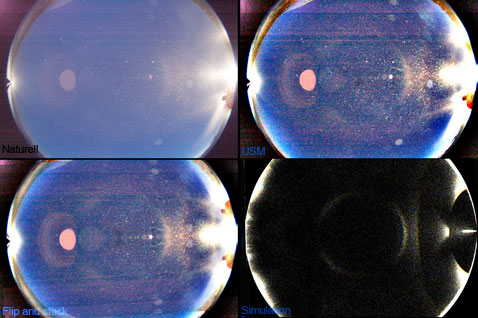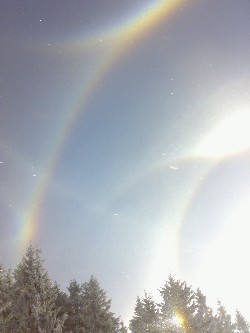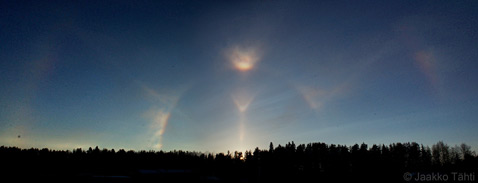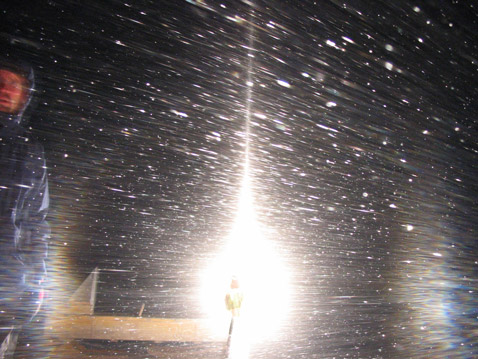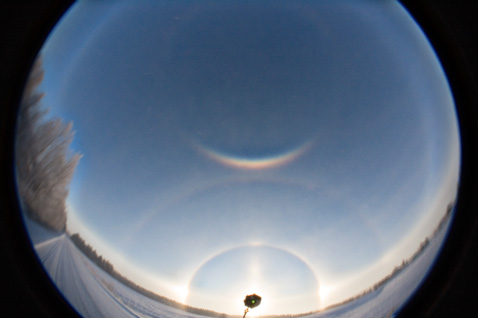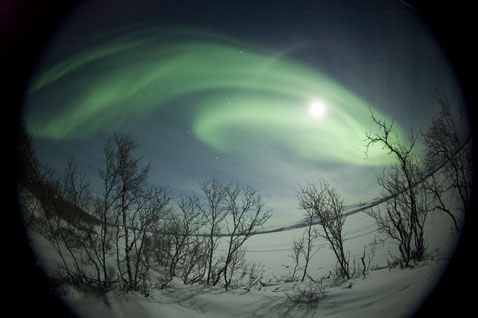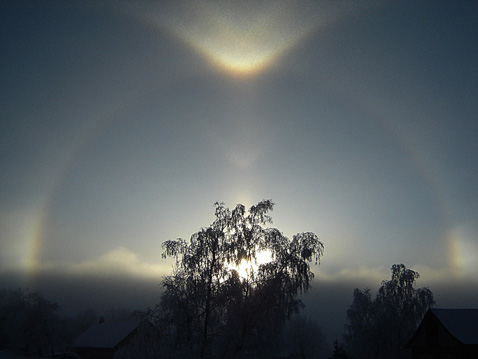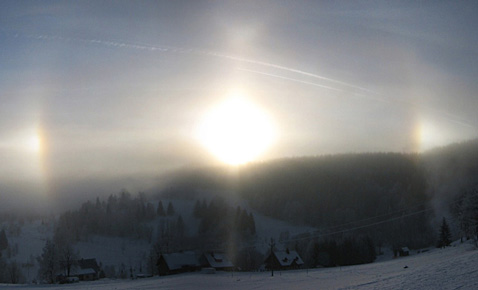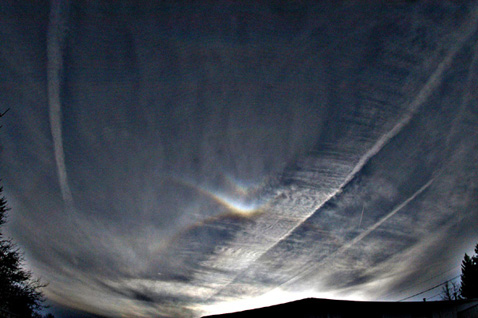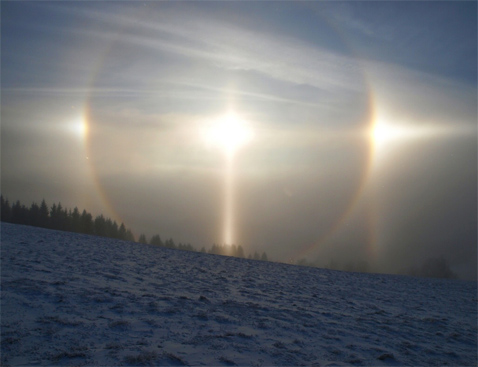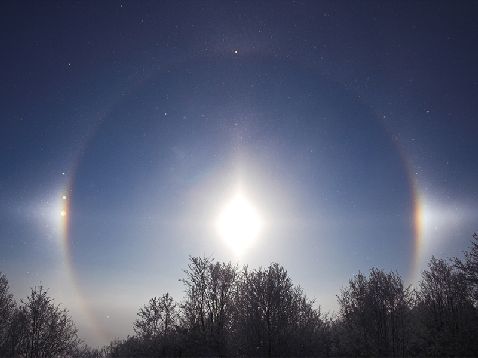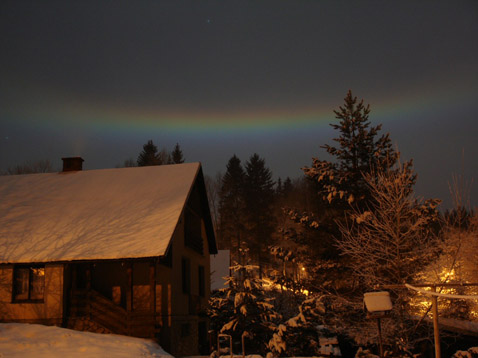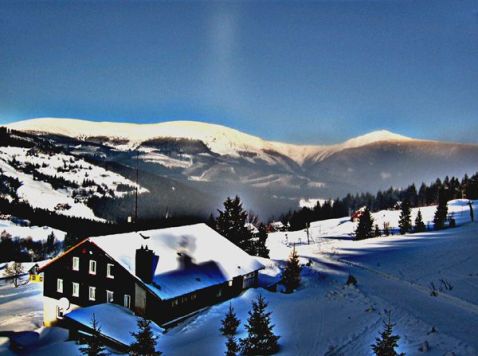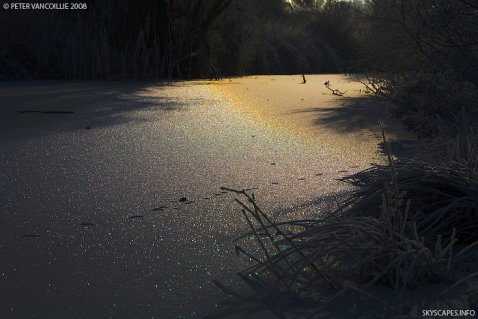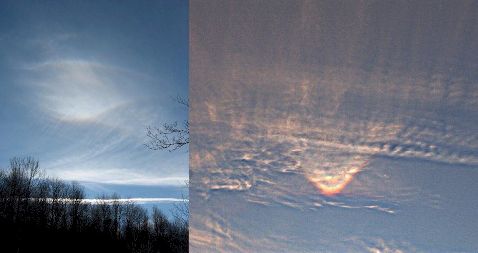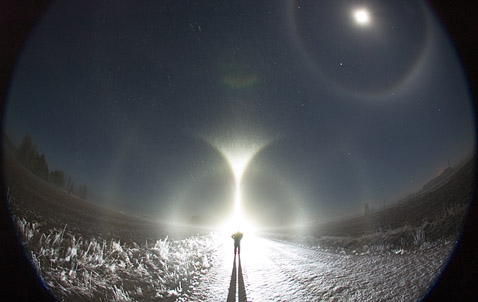Sometimes it happens that when first photos of some halo are taken, more start piling up in the wake. This was the case for example with elliptical halos.
Now the Kilpisjärvi halo expedition seems to have resulted in second Kern photo, this time the light source being Cyclops X-15 spotlight instead of sun. In the images above - which are just versions of one photo - there seem to be two short arcs that match the location of the Kern arc as shown by the simulation.
The simulation (Jukka Ruoskanen's simulation software) is made for light source elevation of 0° which must be very close to the real situation. Thick h/d 0.6-1.0 regular hexagonal plates with tilts of 2° were used for the Kern arc. Thinner plates made also good Kern, but they produced additional circumzenith arc which is not seen in the photos.
In the first days and nights of diamond dust making in Kilpisjärvi we practically encountered every possible mishap. This was one of those nights. For one thing the blocker was not properly in place which resulted in lens reflections. Even worse, the lamp suddenly dimmed when the photo was taken: the battery that was supposed to be full had failed us.
So I had to increase exposure heavily afterwards in photo editing software to light up the dark photo. This resulted in excess noise and horizontal lines. To reduce the noise, mirror images of the photo were stacked ("flip and stack"). More natural versions are also given.
Upon experimenting with various crystal tilts and aspect ratios in the simulation program it became clear that Kern arc was always prominently accompanying the circumzenith arc around 0° light source elevations. From that point of view there is nothing special in Kern showing up in the photo: it must be there.
Wednesday, 30 January 2008
Complex halo display in Destne
One of the most striking halo displays of recent years in the Czech Republic was observed on December 25, 2007 in Destne in the Orlicke Mountains. Diamond dust halo phenomena highlighted the sky shortly after 12 local time (CET) and lasted until sunset.
While skiing, Radek Svoboda took several shots with his cell phone camera and captured a variety of halos including ones like Tape arc (Parry supralateral arc) and heliac arc, as shown by the photo beside. See also another image.
After the inspection of rest of the photos, even diffuse arcs turned up.
Some of the images are featured in the gallery, other uploaded halo photographs of Czech observers can be instantly browsed on the latest uploads page.
Text: Tomas Trzicky
While skiing, Radek Svoboda took several shots with his cell phone camera and captured a variety of halos including ones like Tape arc (Parry supralateral arc) and heliac arc, as shown by the photo beside. See also another image.
After the inspection of rest of the photos, even diffuse arcs turned up.
Some of the images are featured in the gallery, other uploaded halo photographs of Czech observers can be instantly browsed on the latest uploads page.
Text: Tomas Trzicky
Well defined Moilanen arc in Viitasaari
On 23 January Jaakko Tähti was doing product photography in a factory in Viitasaari when he got a phonecall that there was a good halo display in the sky. He could not get outside but had a look at the display from factory window. An hour later, at 13:45, Tähti finally got a chance to go out and took photos from which the above panorama was made.
The halos in the display are the usual ones for snow gun generated displays (ski center was nearby), but the razor sharp form of the Moilanen arc is of a better class. Crystal samples from these kind of appearances could be useful in unveiling the mystery that shrouds the Moilanen arc formation.
Here are four single photos of the display ( 1 - 2 - 3 - 4 ).
The halos in the display are the usual ones for snow gun generated displays (ski center was nearby), but the razor sharp form of the Moilanen arc is of a better class. Crystal samples from these kind of appearances could be useful in unveiling the mystery that shrouds the Moilanen arc formation.
Here are four single photos of the display ( 1 - 2 - 3 - 4 ).
Tuesday, 29 January 2008
Making halos in Kilpisjärvi
On 19th January the four of us, Jukka Ruoskanen, Marko Mikkilä, Ágnes Kiricsi and Marko Riikonen gathered at the Kilpisjärvi biological station in northern Finland to make halos. We had got some evidence that weather conditions in the Kilpisjärvi area might be favourable for ice crystal formation as long as the nuclei are provided. At his home, Marko Mikkilä had already done successful initial experiments of creating halos with a mixture of kaolin and water sprayed in the air, and this time we wanted to do more tests on the system.
During our one-week stay, we were able to create displays on two days and three nights, the temperatures being around -20 °C. The diamond dust cloud that developed seemed to be kilometres wide. This was accomplished with only about 10 litres of water and two spoonfuls of kaolin. The crystal swarm usually lasted about half an hour and then it was time to go back to spray more ( 1 – 2 ). On one night we succeeded in making halos 12 hours continuously.
We also tested a snow blower. A good display had been observed ten years ago in Resolute Bay created by such a machine (see drawings in Sivuaurinko 3/98 on pages 9 and 10). Our impression was, however, that it was not nearly as good as kaolin, and we eventually quit using it.
Mostly we had plate displays ( 1 - 2 ), but on two nights at the beginning of the favourable conditions there were also halos from column and Parry oriented crystals. Diffuse arcs and upper sunvex Parry arc were seen. Moilanen arc was present only on one night for a short while.
We also tried spraying water mixed with montmorillonite (also known as bentonite) on one day and managed to create a weak plate display. This clay mineral is referred to be an even better nucleator than kaolin, but we found its use problematic because of its clumping habit.
After each spraying round photographing the halos was sort of a hassle, there was not much time for fine tuning. The next step in halo making is to have a continuous automated feed of the nucleating mixture. Then the real fun can start.
Text: Ágnes Kiricsi, Marko Riikonen
During our one-week stay, we were able to create displays on two days and three nights, the temperatures being around -20 °C. The diamond dust cloud that developed seemed to be kilometres wide. This was accomplished with only about 10 litres of water and two spoonfuls of kaolin. The crystal swarm usually lasted about half an hour and then it was time to go back to spray more ( 1 – 2 ). On one night we succeeded in making halos 12 hours continuously.
We also tested a snow blower. A good display had been observed ten years ago in Resolute Bay created by such a machine (see drawings in Sivuaurinko 3/98 on pages 9 and 10). Our impression was, however, that it was not nearly as good as kaolin, and we eventually quit using it.
Mostly we had plate displays ( 1 - 2 ), but on two nights at the beginning of the favourable conditions there were also halos from column and Parry oriented crystals. Diffuse arcs and upper sunvex Parry arc were seen. Moilanen arc was present only on one night for a short while.
We also tried spraying water mixed with montmorillonite (also known as bentonite) on one day and managed to create a weak plate display. This clay mineral is referred to be an even better nucleator than kaolin, but we found its use problematic because of its clumping habit.
After each spraying round photographing the halos was sort of a hassle, there was not much time for fine tuning. The next step in halo making is to have a continuous automated feed of the nucleating mixture. Then the real fun can start.
Text: Ágnes Kiricsi, Marko Riikonen
Sunday, 27 January 2008
Kern arc photographed in Finland
On the 17th November I drove 250 kilometers to the town of Sotkamo to check if there were any diamond dust halos. Two weeks earlier I had made the same trip, but the snowguns hadn't produced any halos. This time, however, the ski resort was surrounded by a thick fog cloud in which diffuse halos were visible.
I started searching for a better spot and after a while of driving the cloud started thinning. 22º halo, parhelia and M-arc were present and I took ice crystal samples before continuing the search. Several kilometers later it started looking really good and I stopped the car by a field where the view was unobstructed.
The parhelia were extremely strong, and I made my first observation of 44º parhelia. Other halos were 22º halo, sunpillar, subsun, subparhelia, upper tangent arc, circumzenith arc, 120º parhelia, 46º halo, parhelic circle and M-arc. The 120º parhelia looked like fuzzy pillars.
I took several hundred photos and ran out of memorycard. Luckily I had an old camera with slide film, but as it also ended pretty fast, the only solution was to get a new memorycard from the local town over 10 kilometers away. When I was back, the display was still going on, but the new card also got filled up in half an hour. So it was time to get home.
Next day, as I was having a closer look at the photos I couldn't believe my eyes what appeared on the screen. The circumzenith arc had a faint extension going all around the zenith: the Kern arc. See this photo, which also shows reflected Lowitz arcs. In some of the photos the 46º halo has an angular appearance revealing the 46º contact arcs , which were first photographed in Muonio a year ago ( 1 - 2 ).
Although readily appears in simulations, the Kern arc has been controversial because of the lack of photos. It was first reported by H.F.A Kern in 1895 in the Netherlands and at least six subsequent reports are known. As an explanation for Kern arc formation, raypath 1-3-5 in plate crystals as well as multiple scattering has been suggested. In the Sotkamo display there were 44º parhelia indicative of the latter, but it is not certain whether this mechanism is applicable higher up in the sky where the crystal cloud is optically much thinner.
Single scattering raypath 1-3-5 produces Kern arc easily, especially when the crystals are towards triangular shape and the sun is low. Both of these circumstances were realized in the Sotkamo display where the sun elevation was six degrees and a considerable number of crystals were semitriangular. As for crystal aspect ratio, it is thick plates that are favourable for Kern arc formation. The crystals in the photos seem to be below optimum thickness, but it should be noted that the crystal samples were collected before the peak of the display when Kern arc was not yet occurring and thus the sample may not fully representative.
The simulation of the display was made with populations of plate, Lowitz and column crystals. Fixed multiple scattering probability (0.15) was applied for all populations. Plates were semitriangular and the Kern arc in the simulation is primarily from single scattering 1-3-5 raypaths. Multiple scattering makes the 44º parhelia. Poorly oriented spinning Lowitz crystals made the 46º contact arcs and Lowitz arcs. It is noteworthy that the apparent 22º halo in the simulation is actually made of Lowitz arcs, which may also have been the case in the display. Columns made the weak 22º upper tangent arc. The simulation was made with a program by Jukka Ruoskanen
During recent years we have seen photographs of numerous displays with very bright parhelia. It is probable that at least some of them involved the Kern arc. This might be worth keeping in mind when the next bright plate crystal display comes along.
I started searching for a better spot and after a while of driving the cloud started thinning. 22º halo, parhelia and M-arc were present and I took ice crystal samples before continuing the search. Several kilometers later it started looking really good and I stopped the car by a field where the view was unobstructed.
The parhelia were extremely strong, and I made my first observation of 44º parhelia. Other halos were 22º halo, sunpillar, subsun, subparhelia, upper tangent arc, circumzenith arc, 120º parhelia, 46º halo, parhelic circle and M-arc. The 120º parhelia looked like fuzzy pillars.
I took several hundred photos and ran out of memorycard. Luckily I had an old camera with slide film, but as it also ended pretty fast, the only solution was to get a new memorycard from the local town over 10 kilometers away. When I was back, the display was still going on, but the new card also got filled up in half an hour. So it was time to get home.
Next day, as I was having a closer look at the photos I couldn't believe my eyes what appeared on the screen. The circumzenith arc had a faint extension going all around the zenith: the Kern arc. See this photo, which also shows reflected Lowitz arcs. In some of the photos the 46º halo has an angular appearance revealing the 46º contact arcs , which were first photographed in Muonio a year ago ( 1 - 2 ).
Although readily appears in simulations, the Kern arc has been controversial because of the lack of photos. It was first reported by H.F.A Kern in 1895 in the Netherlands and at least six subsequent reports are known. As an explanation for Kern arc formation, raypath 1-3-5 in plate crystals as well as multiple scattering has been suggested. In the Sotkamo display there were 44º parhelia indicative of the latter, but it is not certain whether this mechanism is applicable higher up in the sky where the crystal cloud is optically much thinner.
Single scattering raypath 1-3-5 produces Kern arc easily, especially when the crystals are towards triangular shape and the sun is low. Both of these circumstances were realized in the Sotkamo display where the sun elevation was six degrees and a considerable number of crystals were semitriangular. As for crystal aspect ratio, it is thick plates that are favourable for Kern arc formation. The crystals in the photos seem to be below optimum thickness, but it should be noted that the crystal samples were collected before the peak of the display when Kern arc was not yet occurring and thus the sample may not fully representative.
The simulation of the display was made with populations of plate, Lowitz and column crystals. Fixed multiple scattering probability (0.15) was applied for all populations. Plates were semitriangular and the Kern arc in the simulation is primarily from single scattering 1-3-5 raypaths. Multiple scattering makes the 44º parhelia. Poorly oriented spinning Lowitz crystals made the 46º contact arcs and Lowitz arcs. It is noteworthy that the apparent 22º halo in the simulation is actually made of Lowitz arcs, which may also have been the case in the display. Columns made the weak 22º upper tangent arc. The simulation was made with a program by Jukka Ruoskanen
During recent years we have seen photographs of numerous displays with very bright parhelia. It is probable that at least some of them involved the Kern arc. This might be worth keeping in mind when the next bright plate crystal display comes along.
Thursday, 24 January 2008
Halo and northern lights
Some ten years ago or so my friends and I went though Finnish Meteorological Institute automatic northern light camera films in search for moon halos. At that time I considered the northern lights as unnecessary noise that disturbed the distinction of halos on those low resolution 8 mm films.
Last Thursday I was photographing a moon halo display in Kilpisjärvi biological station, when suddenly green northern lights moved fast across the halos. It was a rather nice treat and above is one photo of those moments.
Also a 9° halo was in the sky on that night, as shown by this photo. Two nights later the 9° halo reappeared, but the display was much poorer.
Last Thursday I was photographing a moon halo display in Kilpisjärvi biological station, when suddenly green northern lights moved fast across the halos. It was a rather nice treat and above is one photo of those moments.
Also a 9° halo was in the sky on that night, as shown by this photo. Two nights later the 9° halo reappeared, but the display was much poorer.
Wednesday, 23 January 2008
Moilanen arc and diffuse anthelic arcs in Prichovice
A superb halo complex was observed by Petr Kousal on December 25, 2007 in community of Prichovice. He observed 22° halo, parhelia, pillar and also bright upper tangent arc with sunvex Parry arc. Except for these quite frequent phenomena he observed also Moilanen arc, which tips almost touched the 22° halo ( 1 - 2 - 3 - 4 ).
The best event came when he looked towards anthelion point, where diffuse arcs were clearly visible. This observation of diffuse arcs is the first in the Czech Republic ( 1 - 2 - 3 ).
This display was also captured by Martina Pistorova during her afternoon walk to the outlook-tower Stepanka in Prichovice ( 1 ). Analogous halo complex with Moilanen arc was also observed and photographed by Frantisek Kovarik in community Prichovice ( 1 ).
Also Hana Koukalova observed halo complex in the same community. Faint heliac arc is maybe displayed in one of her pictures ( 1 - 2 ). And finally, also Julia Vachkova observed a few halos together with infralateral arc ( 1 - 2 )
Text: Martin Popek, Lukas Shrbeny
The best event came when he looked towards anthelion point, where diffuse arcs were clearly visible. This observation of diffuse arcs is the first in the Czech Republic ( 1 - 2 - 3 ).
This display was also captured by Martina Pistorova during her afternoon walk to the outlook-tower Stepanka in Prichovice ( 1 ). Analogous halo complex with Moilanen arc was also observed and photographed by Frantisek Kovarik in community Prichovice ( 1 ).
Also Hana Koukalova observed halo complex in the same community. Faint heliac arc is maybe displayed in one of her pictures ( 1 - 2 ). And finally, also Julia Vachkova observed a few halos together with infralateral arc ( 1 - 2 )
Text: Martin Popek, Lukas Shrbeny
Monday, 21 January 2008
Moilanen arc in Paprsek
In Czech mountains Ivo Bartos observed diamond dust halos on December 23, 2007 near ski area of Paprsek, which is situated in the highest Moravian mountains.
From 2 to 5 pm he most of the time observed sun pillar and parhelia with fragments of 22° halo. Culmination of the phenomenon occured at 4 pm when Moilanen arc appeared. This is the fourth observation of this arc in the Czech Republic.
The first Moilanen arc in the Czech Republic was observed by Ivo Brezina in January 2003 in Horni Misecky along with other bright halos ( 1 - 2 ).
The second case was by Milan Martinek in Bozi Dar in February 2004, who, besides Moilanen arc, observed also upper sunvex Parry arc heliac arc and maybe Lowitz reflected arcs. The photos of the heliac arc were the first in Czech Republic. The third Moilanen arc was observed together with bright upper tangent arc by Emil Brezina on January 1, 2006 in Vsetin.
Also Moilanen arc observed by Jan Bim on December 20, 2006 in Austrian Alps is noteworthy ( 1 - 2 - 3 ).
Text: Martin Popek, Lukas Shrbeny
From 2 to 5 pm he most of the time observed sun pillar and parhelia with fragments of 22° halo. Culmination of the phenomenon occured at 4 pm when Moilanen arc appeared. This is the fourth observation of this arc in the Czech Republic.
The first Moilanen arc in the Czech Republic was observed by Ivo Brezina in January 2003 in Horni Misecky along with other bright halos ( 1 - 2 ).
The second case was by Milan Martinek in Bozi Dar in February 2004, who, besides Moilanen arc, observed also upper sunvex Parry arc heliac arc and maybe Lowitz reflected arcs. The photos of the heliac arc were the first in Czech Republic. The third Moilanen arc was observed together with bright upper tangent arc by Emil Brezina on January 1, 2006 in Vsetin.
Also Moilanen arc observed by Jan Bim on December 20, 2006 in Austrian Alps is noteworthy ( 1 - 2 - 3 ).
Text: Martin Popek, Lukas Shrbeny
Sunday, 20 January 2008
Two Parry arcs in Ohio
While at work prior to leaving I was outside and happened to look up and saw nice wide tangent arc spreading out. Inside it was a convex Parry, the first decent one since 2000. As I watched and shot photos I could see the more common concave arc and there was also faint supralateral arc and circumzenith arc.
I also visually could see Lowitz arc curving down from upper concave Parry arc and circular lowitz arc near the sunvex arc touching the 22° halo. What a way to start the new year for halos. It was nice to see both Parrys at once. Photos were unsharp masked to enhance the halos.
Text: Michael Ellestad
I also visually could see Lowitz arc curving down from upper concave Parry arc and circular lowitz arc near the sunvex arc touching the 22° halo. What a way to start the new year for halos. It was nice to see both Parrys at once. Photos were unsharp masked to enhance the halos.
Text: Michael Ellestad
Tuesday, 15 January 2008
The arms of parhelia and subparhelia on the Pansky Vrch hill
On December 23, 2007 (1:40 – 3:50 pm) Ladislav Nyc observed during his afternoon walk bright halos in diamont dust. When he went up from inversion cloudiness to see sunrays, on the hill of Pansky Vrch a great spectacle came along. Except for frequent halos like pillar, 22° halo, parhelia and upper and lower tangent arcs also subhalos were visible: bright subsun and subparhelia with arms of parhelia. These arms of parhelia, which join subparhelia and parhelia of 22° halo, are the first ones observed in the Czech Republic. More photos ( 1 - 2 - 3 ).
Also Stanislav Bernard in Sedlonov saw halos during his walk around Orlicke hory, mountains in the north part of the Czech Republic ( 1 - 2 ).
Text: Martin Popek, Lukas Shrbeny
Also Stanislav Bernard in Sedlonov saw halos during his walk around Orlicke hory, mountains in the north part of the Czech Republic ( 1 - 2 ).
Text: Martin Popek, Lukas Shrbeny
Saturday, 12 January 2008
Moon halos in Pec pod Snezkou
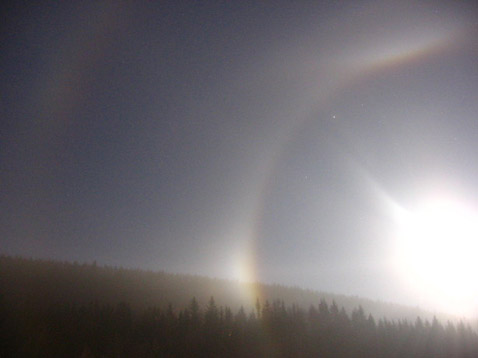
Lower component of the Lowitz arcs may be present as a vague brightening on the 22° halo (right side), see this photo. Lubos Brat observed also halo phenomena in the artificial light and he was the first person in the Czech Republic to take a photo of superparhelia.
More photos of halo phenomena observed in Pec pod Snezkou between December 22, 2007 and January 5, 2008 are available on the Lubos Brat web site Altan Observatory.
Daytime halos were also seen on the 23 December. In the Orlické mountains Hana Tesarova photographed a display with bright circumzenital arc ( 1 – 2 ).
Beautiful circumzenital arc was observed also on December 16, in Western Tatras mountains by Boris (Slovakia), see photo here.
Text: Martin Popek, Lukas Shrbeny
Wednesday, 9 January 2008
Moilanen arc in Mátraszentimre, Hungary
This photo shows the diamond dust display near Mátraszentimre skiing resort in Hungary on 30th December and was taken by photographer Zsuzsanna Tóth. The snow guns were on, and the halo appeared in the early afternoon and lasted about an hour. The display was the best at around 2 p.m. Then the 22° halo, parhelia and upper tangent arc were accompanied by a Moilanen arc. As indicated by the bright parhelia and a less conspicuous upper tangent arc, the display must have been dominated by plate crystals. Unfortunatelly, however, there was no one around who would have collected samples, so the mystery remains unsolved.
Natural diamond dust is very rare in Hungary, due to our temperate continental climate. But this winter has so far been much colder than the average ones, and it has resulted in a pretty diamond dust display without the assistance of any snow guns on 3rd January in Mogyoród. Alexandra Farkas took this picture of UTA, CZA, and supralateral arc. The halos don't show anything extraordinary, still it was a unique sight in Hungarian winter.
Natural diamond dust is very rare in Hungary, due to our temperate continental climate. But this winter has so far been much colder than the average ones, and it has resulted in a pretty diamond dust display without the assistance of any snow guns on 3rd January in Mogyoród. Alexandra Farkas took this picture of UTA, CZA, and supralateral arc. The halos don't show anything extraordinary, still it was a unique sight in Hungarian winter.
Circumhorizon arc in Vítkovice
When I first saw photos by Vaclav Fego captured on December 22, 2007 in Vitkovice in Krkonose mountains I told myself just one thing – wow, that is amazing, I haven’t seen anything similar for a long time! On the images of this Moon halo display is visible bright and colorful circumhorizon arc together with short projections of infralateral arc low above the southern horizon. Also 22° halo with Parry arc and full paraselenic circle are seen. Here is one photo pointed at higher up in the sky and here is a composite image.
The situation captured on the photos is similar to this simulation, made with Halosim by Les Cowley and Michael Schroeder
Circumhorizon arc appears when elevation of the Moon (or Sun) is 58° or more above the horizon. In this case the elevation of the Moon was 66°, which is several degrees more than that of the Sun at noon at summer solstice in the Czech Republic (the inclination of the Moon’s orbit to the ecliptic can position the Moon 5° higher)!
In the same day there was also nice complex display around the Sun:
From Bedřichov u Kralovky, photo by Vladimir Wasserbauer and from Paseky nad Jizerou, photo by Čenda Jirak.
Text: Martin Popek, Lukas Shrbeny
( addition on 10 Jan: more images by Vaclav Fego: 1 - 2 - 3 )
The situation captured on the photos is similar to this simulation, made with Halosim by Les Cowley and Michael Schroeder
Circumhorizon arc appears when elevation of the Moon (or Sun) is 58° or more above the horizon. In this case the elevation of the Moon was 66°, which is several degrees more than that of the Sun at noon at summer solstice in the Czech Republic (the inclination of the Moon’s orbit to the ecliptic can position the Moon 5° higher)!
In the same day there was also nice complex display around the Sun:
From Bedřichov u Kralovky, photo by Vladimir Wasserbauer and from Paseky nad Jizerou, photo by Čenda Jirak.
Text: Martin Popek, Lukas Shrbeny
( addition on 10 Jan: more images by Vaclav Fego: 1 - 2 - 3 )
Diffuse arcs with anthelion on Humlnet webcam
A strange white faint arc appeared on December 17, 2007 on webcam in Pec pod Snezkou, Czech Republic, operated by Humlnet network. Because the webcam is oriented northward, there was a suspicion that at least anthelion could be captured on the photographs. Fortunately, there is an image archive available, so we were able to create stacked image. I used 10 images with apparent anthelion for processing in Registax. The result revealed together with anthelion also quite bright diffuse arcs.
There are another 2 examples of webcam images with halos: Parhelion captured by Hydronet webcam in the Jizera Mountains on December 13, 2007.
Infralateral and supralateral arcs on Humlnet webcam in Zacler (December 25, 2007).
Text: Martin Popek, Tomas Trzicky
There are another 2 examples of webcam images with halos: Parhelion captured by Hydronet webcam in the Jizera Mountains on December 13, 2007.
Infralateral and supralateral arcs on Humlnet webcam in Zacler (December 25, 2007).
Text: Martin Popek, Tomas Trzicky
Sunday, 6 January 2008
22° halo on snow surface with horizontal color segments
This 22° halo was seen on a thin snow layer which formed on a freshly frozen river from power plant induced precipitation and freezing mist. The dark area inside the 22° halo is prominent, indicating well developed solid crystals that scatter light only at halo angles.
The photo shows also broad horizontal segments of cyan and magenta in the outer areas of 22° halo. These segments seem to be very sensitive to the variations in the camera positioning, changing their position relative to the 22° halo and ground features, as shown by other photos taken by Peter Vancoillie.
I have no explanation to offer. The display was seen in Ghent, Belgium on 21 December 2007.
The photo shows also broad horizontal segments of cyan and magenta in the outer areas of 22° halo. These segments seem to be very sensitive to the variations in the camera positioning, changing their position relative to the 22° halo and ground features, as shown by other photos taken by Peter Vancoillie.
I have no explanation to offer. The display was seen in Ghent, Belgium on 21 December 2007.
Friday, 4 January 2008
A diversity of surface halos in Juva
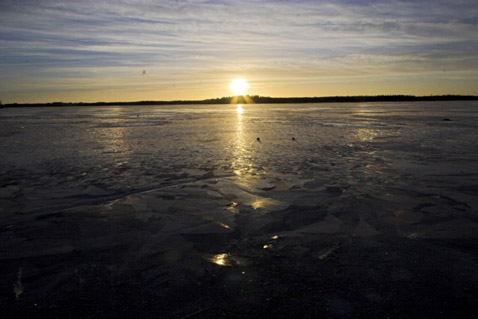
Piikki took photos of the responsible ice crystals. They seem to be frost crystals, which top ends has plates grown horizontally. See here and here. Crystals are large; the photos were taken with a standard lens. Some crystals show possible cavities.
The halo display on the ice surface was changing as one moved on the ice. This image shows faint extensions from the parhelia towards the observer. The display does not seem symmetrical, but slightly distorted towards right. This could be caused by uniform atsimuthal orientation of the crystals prisms. At least the crystal photos give an impression of all crystals having similar orientation. This is clear evidence that crystals are frost crystals, not fallen from the sky. Locally inclined surface may also be affecting the halo features. The image with parhelia extensions was taken with camera lens touching the ice, features close to the camera are thus formed in small surface area. Preferential atsimuthal orientation of crystals may be more likely in small than large surface area.
Opposite to the sun a white glow was seen at the subanthelic point (photo taken with camera on tripod). Airborne plates do not produce such effect, at least in simulations. Reflecting complex ice surface or/with frost crystals here must be chancing the rules so that the glow can be formed. Could this be called just a heiligenschein?
At around 120° from the sun on both sides white brightenings (arrow) were observed, indications of 120° parhelia. In airborne crystals the usual 1-3-4-2 and 1-3-4-2-1 raypaths for 120° parhelia and subparhelia are not effective at very low sun elevations, but in frost crystals external reflection from ice surface may allow these raypaths. In airborne crystals other raypaths can make 120° parhelia at low sun, but crystals deviating from regular hexagonal shape are required. Here the frost crystals seem to be pretty regular in shape.
Halos were also observed at the nadir region. These are possibly patches of a circumzenith arc caused by light reflection from ice surface. The colors, on the other hand, seem similar to the halos from 60° refracting angle. According to the observer, sun is most likely towards the upper left corner in the photo.
A question remains whether these halos should be called with sub -prefix or not. This has some significance, because sub-120° parhelia and sub-circumzenith arc (or circumnadir arc) has not been observed yet. Subhalos from airborne plate crystals are characterized by a reflection from bottom basal face. Here the bottom basal face needed for the subhalos formation may be missing or is only partially developed as crystals are at attached on the ice.
Most likely the formation of the halos is to greater amount contributed by a reflection from ice surface before or after the rays enter or exit the crystal. If we take it that a subhalo must arise from ray path fully inside one crystal, then these are not subhalos.
Marko Riikonen, Jarmo Moilanen
Parry Arcs Over Central Europe
December 22nd was a day of complex displays over Central-Europe. While Hungary was covered with thick fog, mountain peaks above 900m witnessed sunshine and favourable conditions for halo-formation. Attila Kovács took the photo of the suncave Parry arc on Bálvány in the Bükk Mountains 956m above sea level. The display started with bright parhelia that appeared at 12:05 UT and lasted about half an hour. At around 12:30-12:40 the complex display began to emerge. First the 22° halo with the upper tangent arc. Altogether, a 22° halo, parhelia, UTA, a long section of the parhelic circle, CZA, supralateral arc and the sharp suncave Parry arc were visible. The Parry arc lasted about 5-10 minutes. There is unfortunatelly no report about the anthelic side.
Although the Czech Republic is two countries away towards the northwest, the distance is not that great for crystals forming a display in high clouds, especially that the Hungarian Parry observation was made in the north of the country. On the very same day Martin Popek photographed an attractive sunvex Parry in Nýdek.
Although the Czech Republic is two countries away towards the northwest, the distance is not that great for crystals forming a display in high clouds, especially that the Hungarian Parry observation was made in the north of the country. On the very same day Martin Popek photographed an attractive sunvex Parry in Nýdek.
Tuesday, 1 January 2008
Diamond dust display with a possible new halo
On the evening of 22th December weather conditions finally changed to better. Humidity was up with temperature around -8°C. At the Louekallio ski-resort snow guns produced a crystal cloud and action lasted few hours until crystals suddenly vanished.
Singly oriented columns dominated the swarm. With HID-modded Cyclops Thor Platinum X-15 lamp the display looks quite the same what we have seen already in haloreports, except that there is weird spots on both sides of the upper tanget arc (photo above, see also enhanced image). They seem to extend through the 22° halo towards the lamp, but this may be due to divergent light. In simulations arcs that bear some resemblance to these spots can be produced with slightly tilted Parry crystals, but we certainly need more photos to say what is going on.
Also Moilanen arc appears in the photo. At first glance it may seem to be
connected with the new effect, but closer look reveals they are two separate halos. Diffuse arcs were observed opposite to the lamp.
In the moon light, circumscribed halo, infralateral arcs, 46° halo and full parhelic circle were seen. The long Wegener arc, which continues close to infralateral arcs, was not seen visually. See also another photo of this stage. Later on ice crystals turned to be more randomly oriented. Moon elevation was 52°.
Similar column dominated display was also noticed by Arto Oksanen in Muurame. See his photos here. When 0ksanen first noticed the display, there was Wegener arc above the parhelic circle and he hurried for the camera. Unfortunately, the best moment was gone when he was back. "By the time I got camera from inside, halos had weakened and of parhelic circle only a trace was visible", Oksanen tells.
Singly oriented columns dominated the swarm. With HID-modded Cyclops Thor Platinum X-15 lamp the display looks quite the same what we have seen already in haloreports, except that there is weird spots on both sides of the upper tanget arc (photo above, see also enhanced image). They seem to extend through the 22° halo towards the lamp, but this may be due to divergent light. In simulations arcs that bear some resemblance to these spots can be produced with slightly tilted Parry crystals, but we certainly need more photos to say what is going on.
Also Moilanen arc appears in the photo. At first glance it may seem to be
connected with the new effect, but closer look reveals they are two separate halos. Diffuse arcs were observed opposite to the lamp.
In the moon light, circumscribed halo, infralateral arcs, 46° halo and full parhelic circle were seen. The long Wegener arc, which continues close to infralateral arcs, was not seen visually. See also another photo of this stage. Later on ice crystals turned to be more randomly oriented. Moon elevation was 52°.
Similar column dominated display was also noticed by Arto Oksanen in Muurame. See his photos here. When 0ksanen first noticed the display, there was Wegener arc above the parhelic circle and he hurried for the camera. Unfortunately, the best moment was gone when he was back. "By the time I got camera from inside, halos had weakened and of parhelic circle only a trace was visible", Oksanen tells.
Subscribe to:
Posts (Atom)
